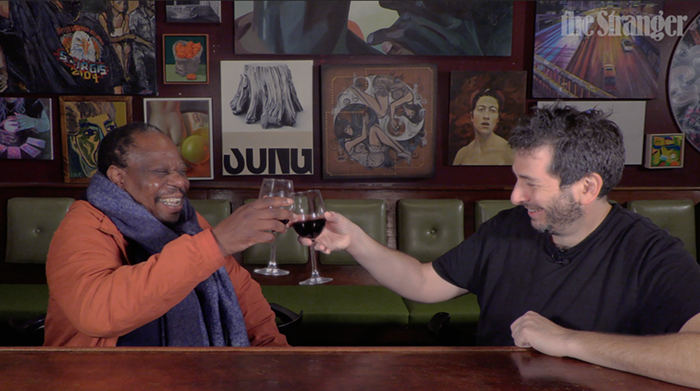by Hubert & Kerascoet
(NBM/ComicsLit) $14.95.
This French comic reads very much like a lost Tintin adventure, if Tintin were a virginal dominatrix working in a brothel plagued by a serial killer. Blanche, a poor maid circa 1930, vows to avenge the brutal murder of her sister. The trail leads to the best little whorehouse in Paris. The prostitutes, including a leggy transvestite named Josephine, take Blanche in, and soon she has made a regular paying gig of refusing her virginity to masochistic wealthy men.
The mystery is involving and proceeds at a sprightly pace, and the small, colorful panels and terse dialogue really do evoke the best of Hergé. Perhaps most striking is the fact that the story is riddled with explicit sex, but the authors take a downright European perspective on it: You get the sense that if Blanche had found a job at the zoo, the tone of the story would not change much. There's no creepy Skinemax vibe here at all. It's refreshing to see a sex-positive story that isn't an erotic adventure and heartening to see a female lead character who's quick-witted, brave, and perfectly willing to accept virtually every sexuality under the sun. There's no American analogue for this kind of breathless comic-book mystery. It's all so perfectly French. PAUL CONSTANT
(Dark Horse) $49.95 each.
When EC Comics' Tales from the Crypt died at the hands of crazed parents, Senate subcommittees, and the Comics Code Authority, horror comics took a dirt nap for nearly a decade. Thankfully, Warren Publishing picked up exactly where EC left off, pumping out books like Blazing Combat, Eerie, and Creepy in the mid-'60s.
There have only been a handful of exceptional horror comics in the last 50 years—most recently, Dirk Manning's Nightmare World—but Creepy perfected the anthology horror formula spawned by EC. Creepy was essentially the reanimated corpse of Tales from the Crypt, with six- to eight-page stories filled with vampires, the occasional spaceship, a ghoulish narrator—Uncle Creepy stands in for the Crypt Keeper—and ironic, sometimes-goofy and/or predictable twist endings where evil mummy spirits possess murderous archeologists' bodies and nagging wives turn into werewolves.
Creepy covers much of the same ground as Crypt—albeit in a smarter, slightly more grown-up way—and while Crypt took at least a dozen issues before it really hit its stride, Creepy's first 10 issues are packed with stellar work from comics legends such as Archie Goodwin, Alex Toth, and Frank Frazetta (who has a kick-ass African werewolf story in Creepy's first issue) and stripped-down retellings of horror/sci-fi classics like Edgar Allan Poe's The Tell-Tale Heart and Isaac Asimov's I, Robot.
Dark Horse's archival collections are absolutely beautiful and a must-read for anyone who's ever enjoyed any of EC's books or TV shows like The Twilight Zone and Night Gallery. That said, these hefty hardcovers are ludicrously expensive (50 bucks for five 48-page issues), and with nearly 150 issues in Creepy's 19-year run, Dark Horse has effectively priced everyone but the most anal-retentive completist collectors out of the market. JONAH SPANGENTHAL-LEE
by Brian Azzarello and Lee Bermejo
(DC Comics) $19.99.
In the Batman comics when I was growing up, the Joker was never anything more than a goofball bank robber in clown makeup. Then Ronald Reagan happened, and Batman comics got all dark and miserable. In a two-year period, the Joker killed one of Batman's sidekicks, paralyzed Batgirl in Alan Moore's The Killing Joke, and committed suicide in Frank Miller's The Dark Knight Returns. After that rampage, scary Joker went away for a while, but then Heath Ledger dropped his scary-as-fuck, mutilated anarchist Joker on us in The Dark Knight movie that made a kajillion dollars—a far cry from the cackling clown on the Super Friends Hour and Batman: The Animated Series.
Now Brian Azzarello's Joker continues the trend of evil, fucked-up Jokers. The Clown Prince of Crime is improbably released from Arkham Asylum, supposedly cured. But it's not long before the Joker posses up with his old henchmen and starts popping pills, flaying men alive in strip clubs, and shooting gangsters in Italian restaurants as he attempts to regain his place at the top of Gotham City's criminal underworld.
Azzarello brings the same neo-noir style of his Vertigo series 100 Bullets, tossing down-on-his-luck goon Jonny Frost into the midst of the Joker's comeback tour. Frost rides shotgun with the Joker through Gotham's underground, going up against reimagined versions of Killer Croc, the Penguin, and the Riddler, who've all been given the "real world" feel of the two most recent Batman films.
Batman takes a backseat in Joker, not showing up until the last few pages of the book, and without any Bat-distractions, Azzarello takes the time to methodically unravel the Joker's sociopathic philosophy before the inevitable showdown with the Dark Knight.
Every grimy detail of Azzarello's Joker-blighted Gotham City is perfectly captured in Lee Bermejo's paint-and-pencil art. The pair seems to have a knack for dissecting DC's greatest villains—they previously broke down Lex Luthor and Superman's rivalry in Lex Luthor: Man of Steel—and Joker deserves to sit alongside Miller's and Moore's revered works on nerds' bookshelves everywhere. JONAH SPANGENTHAL-LEE
edited by Julia Wertz
(Three Rivers Press) $12.95.
I don't know why The Stranger didn't think of it first. Julia Wertz (author of the largely non-fart-related comic The Fart Party) edits this anthology of cartoon adaptations of other people's "I saw you" ads (most commonly, the artists chose Craigslist's "Missed Connections" to illustrate, but The Stranger and a few other alternative weeklies show up frequently, too). The end result is a book collection that's just as endearing and occasionally haunting as the I Saw U section of this here paper.
There are a few variations on the idea that men who place missed-connection ads are creepy, balding, old, and fat, but a few artists play up the romantic angle to great effect. Adam Kidder's cartoon is a two-decade-long odyssey involving a dead grandmother. Cathy Leamy magically transforms a colonoscopy into something adorable. Kazimir Strzepek tells a tragic mini-romantic-epic about how missing the 43 bus to the U-District can change a life.
The cumulative effect of I Saw You... is to sing the praises of city life: all these young, attractive people wandering around in sexy boots, arguing about bobcats, falling over drunk in bathrooms, and being hot and homeless. Gay or straight, male or female, people in cities fall in love a little bit all the time; sometimes it seems as though that missed potential is the engine that powers things and keeps people going about their business every day. Wertz could put out one of these books every year, and if the quality of the cartoonists were to hold up, it would still be fascinating a decade from now. PAUL CONSTANT
by Matthew Sturges, Bill Willingham, and various artists
(Vertigo) $9.99.
Look. I liked Sandman as much as any self-respecting comic-book nerd. But looking back now, I'd be perfectly willing to somehow make it so Neil Gaiman never wrote that comic book, just so DC's mature-reader line didn't read like a orgy of Sandman fan fiction. House of Mystery is possibly the worst offender of the lot: People—pirates! spacemen!—are stranded in an interdimensional house with a large bar in it, and instead of paying for their drinks, they tell stories to each other. It's another unfortunate side effect of Gaiman's legacy that comics like this have to spend a good portion of their pages blathering on about the importance of storytelling, like a Reading Rainbow of the damned.
You should learn how to tell a story well before you tell a story about storytelling, and these two authors (it took two people to write this shit?) only have gimmicks—one guy really likes ham, so he talks about it all the time, and the lead character, who is ostensibly an adult, is still hurting from the failures of her father. There's a plot here, something about an unlikely group of people coming together to overcome an evil force, but who cares? This type of proto-goth pandering makes me embarrassed to read comics. The art is serviceable, though. PAUL CONSTANT ![]()


















